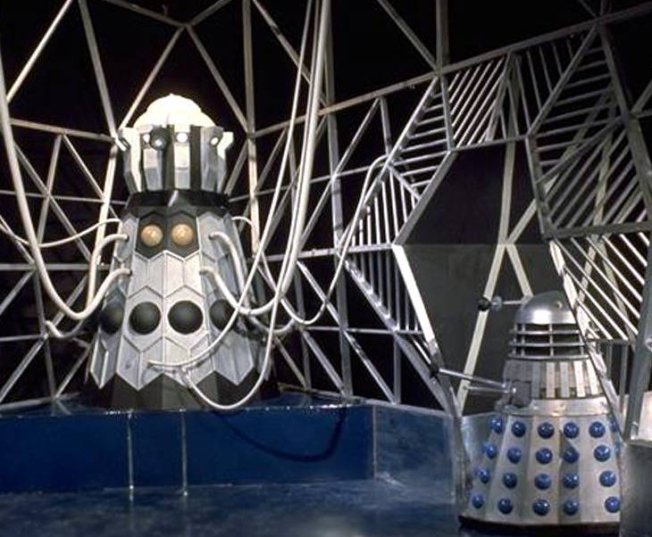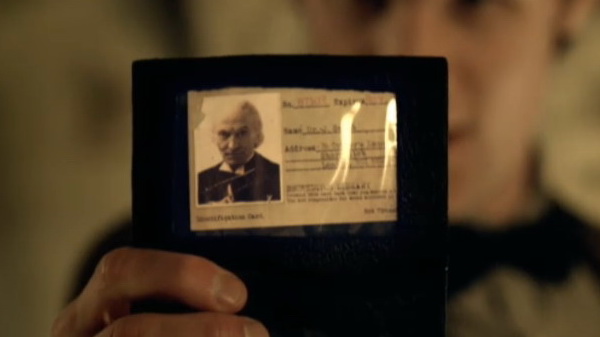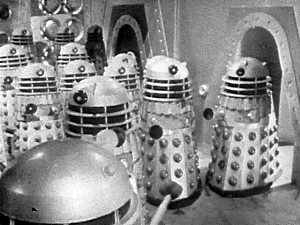The Wheel in Space marks the end of Doctor Who’s Fifth Season and the almost constant run of missing episodes which have plagued marathon viewers since the beginning of Season Three. Season Six is complete, save for the penultimate serial The Space Pirates, and two episodes of the eight part serial The Invasion. Thanks to the brilliant work of Cosgrove Hall. the two missing episodes of The Invasion have been animated and the complete serial is available for viewing on DVD.
The Cybermen made their fourth appearance in 18 months in The Wheel in Space. With the temporary retirement of the Daleks in the last serial of Season Four, the Cybermen had assumed the mantle of the Doctor’s number one enemy. Whereas the Daleks were previously guaranteed to appear in two serials per season, Terry Nation’s attempts to sell his creations to the US saw the Cybermen snatch their title as favourite recurring monsters. Their appearance in The Wheel in Space, however, was a great deal more subtle than in previous adventures. Not seen until the cliff hanger of episode two, their screen time was nearly as limited as their speech. The somewhat verbose sing-song voices of The Tenth Planet Cybermen were replaced by almost mute monsters with more human voices. Now possessing three silver fingers, the Cybermen’s principal terror derived from them silently emerging unexpectedly from anywhere on the Wheel.
The hints of humanity that the first generation Cybermen possessed were long gone, with the cyber creatures now described by the Doctor thus: “Their entire bodies are mechanical and their brains have been treated neuro-surgically to remove all human emotions, all sense of pain. They’re ruthless, inhuman killers!”. These Cybermen, the Doctor said, need to colonize and have the treasures of earth.
The emotionless Cybermen provide a brilliant juxtaposition to the Doctor’s newest companion, Zoe Heriot. 15 year old Zoe is an astrophysicist and astrometricist first class and employed as the Wheel’s parapsychology librarian. Her perfect recall of scientific facts and ability to undertake mental calculations faster than a hand-held calculator are the consequence of her being brainwashed by the City’s educational institution. The processes by which she was educated are not revealed, although one can only guess that they were somewhat similar to those encountered by the First Doctor’s companion, Vicky. Coming from 2493, Vicky outlined to a stunned Barbara in The Rescue how her schooling comprised of being hooked up to a machine for only an hour a week. Zoe, however, comes from a much earlier time, perhaps the early 21st Century, so it’s possible that the education system was not the same. Wood and Miles in About Time argue that the character of Zoe would never work in a current day series “largely because most of her functions could be served by an idiot with a laptop”. With the digital age not even dreamed of in 1968, Zoe was one of the brainwashed bureaucrats that many feared would envelop us in the future.
An unfortunate consequence of Zoe’s education is she is entirely logic driven and completely unable to cope in unexpected circumstances. She is described as being without emotion twice in one day by her co-workers on the Wheel. Rob Shearman in Running Through Corridors described her as “a robot wanting to be a human being”. Shearman’s analysis of Zoe on page 266 is so well written as to warrant me quoting it in full.
Someone else enslaved to logic is Zoe Heriot. She’s a much darker character than I’d ever realised. Whitaker’s script rather brilliantly only hints that she comes from a pitiless totalitarian regime, where young children are taken and brainwashed so that they can come out the other end supergeniuses – capable of holding a huge amount of information, but not the wherewithal to respond to it emotionally. She’s just another Cyberman.
Zoe’s brainwashing was quickly detected by the Doctor who responded to her with perhaps one of his most memorable comments, “Logic, my dear Zoe, merely enables one to be wrong with authority”. During the course of the serial the limitations she faces because of her reliance on logic become painfully clear. Jamie and Zoe’s conversation in the Wheel Operations room during episode five evidences her growing disillusionment, and foreshadows her ultimate decision to stow away in the Tardis.
JAMIE: Oh, there is something you don’t know, then.
ZOE: There’s too much I don’t know. I was trained to believe logic and calculation would provide me with all the answers. Well, I’m just beginning to realise there are questions which I can’t answer.
JAMIE: You’re just not trained for an emergency like this.
ZOE: Well, that’s the whole point. What good am I? I’ve been created for some false kind of existence where only known kinds of emergencies are catered for. Well, what good is that to me now?
JAMIE: Hey, we’re not done yet, you know.
ZOE: And if we survive? What then, Jamie? Suppose we do get ourselves out of this mess. What have I got left? A blind reliance on facts and logic?
When Zoe is found in the TARDIS’s magic chest at the story’s end Jamie’s immediate reaction is to say that it’s impossible for her to go with them. This of itself is quite extraordinary given that he voiced no such concerns when Victoria hitched a ride after her father’s death in The Evil of the Daleks. Perhaps Jamie was secretly hoping that the Doctor would pop back and pick up Victoria from Brittanicus Base? The less polite might argue that Jamie wanted the Doctor all to himself! The Doctor responded to Zoe’s request to stay by saying that it wasn’t impossible but “something that we have to decide”. It appears that the TARDIS is a democracy and that the Doctor is not the sole decision maker. This is in stark contrast to the First Doctor’s tenure where the Ship was clearly his own, to do with as he pleased. Kidnapping is something that the Second Doctor would never acquiesce to.
To help Zoe decide if she wanted to accept the challenges of life in the TARDIS, the Doctor projected his thought patterns onto a monitor and the reprise from episode two of The Evil of the Daleks was seen. In the break between Seasons Six and Seven the BBC aired the first ever Doctor Who repeat, The Evil of the Daleks, and this was scripted into both episode six of The Wheel in Space and episode one of Season Six, The Dominators. This was the first and only time that a repeat was scripted into a serial. The viewers had to wait for Zoe’s decision on whether to stay with the Doctor and Jamie.

The Evil of the Daleks was the first Doctor Who serial ever repeated and the first and only repeat to be scripted into a serial
Another first for The Wheel in Space was the use of the Doctor’s pseudonym, John Smith. When Gemma Corwyn, the Second-in-Command of the Wheel and a particularly strong and well developed female character, asked Jamie what the Doctor’s name was he was stumped. “The Doctor” was the only name by which Jamie knew this mysterious man with whom he’d lived and travelled for the past two years. Glancing over at some medical equipment manufactured by John Smith & Associates Jamie replied, “Er. John Smith”. Later, when the Doctor recovered from his Servo-Robot induced unconsciousness and Corwyn introduced him to Zoe, Jamie had to nudge the Doctor into recognizing that his name was John.

The piece of medical equipment which inspired (the now literate) Jamie to give the Doctor the alias “John Smith”
The Doctor would go onto use the alias John Smith dozens of time thereafter. It could be argued that Jamie’s naming of the Doctor was a mere coincidence and that he was already known by that alias. In the Series Five episode, The Vampires of Venice, the Doctor produced a library card with the First Doctor’s image on it and the address 76 Totter’s Lane. This may well be another example of retroactive continuity as previously discussed in my review of The Abominable Snowmen. Interestingly enough, on one occasion when the Doctor didn’t use the alias of John Smith (Tooth and Claw) he adopted the name James McCrimmon instead. What a lovely nod to Jamie that was.

The Eleventh Doctor shows his library card bearing the name and photo of Dr John Smith in The Vampires of Venice (2010)
The Tenth Doctor identifies himself as James McCrimmon in Tooth and Claw (2006)
It is important to be mindful, however, of the voluminous amounts of criticism that have been directed at The Wheel in Space. Frequently dismissed for being the last of an almost continuous stream of “Base under Siege” stories in Season Five, The Wheel is somewhat slow and features a great deal less of the Doctor then generally seen. Patrick Troughton was on holidays during episode two when the Doctor is conveniently unconscious for the whole episode. When he does appear not a great deal happens. This general disaffection with the story is perhaps best summed up by Cornell, Day and Topping in The Discontinuity Guide (1994) when they describe the serial like this:
Dull, lifeless and so derivative of other base-under-siege stories that it isn’t really a story in its own right. Despite the detailed Wheel setting, the galloping lack of scientific credibility is annoying, and the Cybermen are so bland and ordinary that they could have been any other monster. Generic speed-written tosh.
Notwithstanding this criticism, The Wheel in Space was placed at 156 in the 2009 Doctor Who Magazine Mighty 200. That was well above several other Troughton serials including The Krotons (166), The Dominators (191), The Underwater Menace (194) and The Space Pirates (195). As two episodes are held in the BBC Archives, and have been released on the Lost in Time DVD, it is well worth disregarding the consensus and giving The Wheel in Space a view. It’s worth it just to see the lovely Wendy Padbury introduced as Zoe.

The Wheel in Space was originally broadcast in the UK between 27 April and 1 June 1968. Episodes 3 and 6 of The Wheel in Space are held in the BBC Archives and have been released on the triple DVD set, Lost in Time.
Vivien Fleming
©Vivien Fleming, 2013.
REFERENCES:
Paul Cornell, Martin Day & Keith Topping, The Discontinuity Guide, Virgin Publishing Ltd: London,1995.
Robert Shearman & Toby Hadoke, Running Through Corridors. Rob & Toby’s Marathon Watch of Doctor Who. Volume 1: The 60s, Mad Norweigan Press: Illinois, 2010.
Tat Wood & Lawrence Miles, About Time. The Unauthorized Guide to Doctor Who 1966-1969 Seasons 4 to 6 Volume 2. Mad Norweigan Press: Illinois, 2010.















